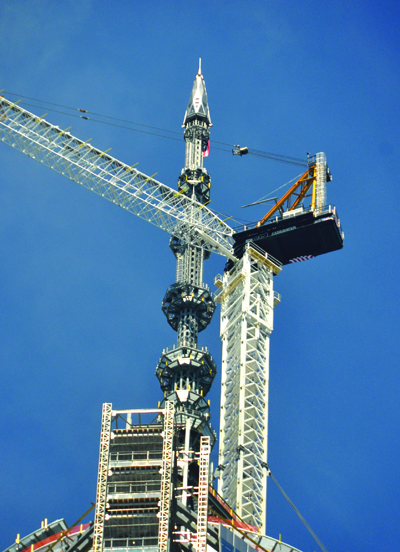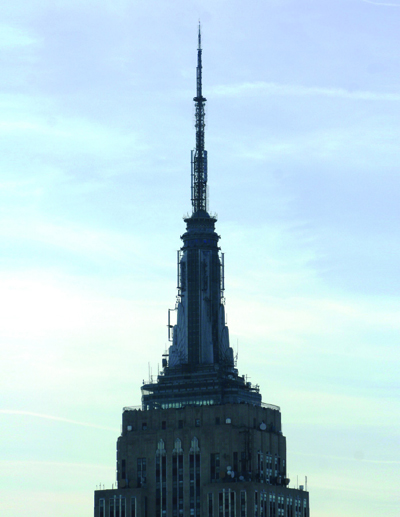NYC Stations Brace for WTC Tower Battle

Workers in New York install the spire on 1WTC on May 10, making it the tallest building in the Western Hemisphere.
NEW YORK—Eleven years, seven months and thirty days after most of New York City’s TV transmission infrastructure was destroyed in the attack that demolished the World Trade Center, crews completed hoisting the spire of the new One World Trade Center into place on May 10.
At a symbolic 1,776 feet above ground, the tip of the spire makes the new 1WTC the tallest building in the Western Hemisphere. It also touches off a fight for broadcast tenants between the new building and its long-established competitor in midtown Manhattan, the Empire State Building.
After the 9/11 attack displaced nine TV stations and four FM stations that had been using the original World Trade Center as a transmission site, Empire became a crowded, complicated place as building management scrambled to reconfigure antennas in the limited mast space available and to add transmitter rooms on two additional floors of the historic building.
Eight blocks north and two blocks west, the Durst Organization quickly reconfigured its own 4 Times Square skyscraper, which had just been completed with a limited FM auxiliary facility on its roof. Project Manager John Lyons, now a Durst vice president, spent much of 2003 overseeing the installation of a new 300-foot mast and new transmission facilities now used for either main or backup purposes by 11 FM stations and four TV stations.
When Durst became a co-developer of the new 1WTC in 2010, Lyons ended up in charge of the high-profile task of designing and attracting tenants for the new broadcast facility.
“It’s definitely different from 4 Times Square. It’s easier in one respect because you’re building from scratch,” Lyons said, with no existing broadcast facilities in place that have to be maintained during construction.
‘PLUG-AND-PLAY’
Like 4 Times Square, Lyons says the new 1WTC broadcast facility is being built as a “plug-and-play” operation.
“The Durst Organization is putting in all the infrastructure,” he says. “As in 4 Times Square, we’re providing HVAC and electrical. The emergency generator is physically in the building already. We’re going to be putting in main and backup power. The chiller plant is already in the building, and we’ll have dedicated service from all the telecom providers.”
Unlike 4 Times Square, where most broadcasters ended up in individual transmitter rooms that were carved out of mezzanine space during the 2003 rebuild, the transmitter area at 1WTC will be an open area surrounding FM, VHF-TV and UHF-TV combiners.

The empire state Building currently hosts trans- mission facilities for 12 new york city area TV stations and 19 fm stations. “The only thing for broadcasters to do will be to put in their transmitting equipment and their combiner modules, and we’ll be ready to go,” Lyons said of the new facility, which he expects will be ready for broadcasters to sign on sometime in 2015.
Whether broadcasters will be rushing to move their facilities downtown is, quite literally, a multi-million dollar question. In a prospectus filed last year for an initial public offering, the Empire State Building disclosed that it earned more than $16 million in 2010 from broadcast leases, which on average had about seven more years to run.
With its status as the city’s tallest building soon to expire, Empire’s operators warned investors in the prospectus that the completion of 1WTC “could have a negative impact on revenues from our observatory operations and/or broadcasting revenues.”
Assessing that impact isn’t easy, though.
“We’ve talked to everybody as a group and now we’re going back and having individual discussions,” is all Lyons will say about the state of Durst’s negotiations with potential tenants at 1 World Trade Center. If that seems terse, it’s one sentence more than anyone else in New York is willing to say for the record. Aside from its IPO prospectus, Empire State Building management has consistently declined to comment at all on the building’s new competitor. Broadcasters are also keeping quiet about their plans, with many citing confidentiality agreements they were asked to sign during negotiations.
BIG DECISIONS
Behind those closed doors, the city’s TV stations in particular have some big decisions to make.
“In the closing days of analog TV, the coverage from Empire never approached what they had from the World Trade Center, or even what they had at Empire back in the days before the World Trade Center was built out,” said veteran New York engineer Bob Tarsio, now owner of Broadcast Designs Inc.
Tarsio, who had FM experience at both Empire and the World Trade Center, acknowledges that each site has its strength: Empire is more centrally located over the city’s population core, while the greater height at 1WTC offers better broad-area reach for stations at that location.
Tarsio says TV stations that move to a brand-new antenna at the new 1WTC could see big benefits.
“The VHF antenna at Empire just isn’t doing the job,” he says. “It would probably be just as expensive a job to redo it at Empire as to do it at the World Trade Center.”
“They’ll go out further than they’re covering now,”Lyons says of the pitch he’s making to potential TV tenants. “But because it is so much higher, we also have to pay attention to the immediate urban market so they can keep the population coverage they presently have.” Lyons says he’s also reminding potential tenants that a move downtown can give them more space and more reliable backup power than they now enjoy at Empire, which still lacks a central backup power supply if Con Edison’s power goes out.
MONKEY WRENCH
In the world of 2013, far from the post-9/11 urgency that prompted the intense infrastructure building boom of the early 21st century, there are factors that go beyond the purely technical.
“The repack is really throwing the ‘monkey wrench’ into this,” Lyons agrees, adding that the issue of refarming the UHF spectrum is creating plenty of questions and very few answers.
“Everybody’s talking about what’s going to happen, when is it going to happen, is it going to take a second pass or a third pass before things get ironed out,” he said.
That uncertainty is keeping Lyons from being able to specify a final antenna configuration for the upper 280 feet of the 408-foot mast that now rises from the 1368 foot rooftop. (The lower portion of the mast is ringed by three platforms that will sup- port ENG receivers, cameras, point-to-point microwave, STL and other non-broadcast uses.)
As at 4 Times Square, Lyons plans to put up broadband antennas to cover FM and the entire TV spectrum, but he’s hesitant to place any orders until he—and his potential tenants—can get a better idea of what that spectrum will be, especially at UHF.
“We’ve had discussions with a lot of the manufacturers,” he says. “There have been no orders placed yet. We’re still waiting for repacking.”
Get the TV Tech Newsletter
The professional video industry's #1 source for news, trends and product and tech information. Sign up below.
